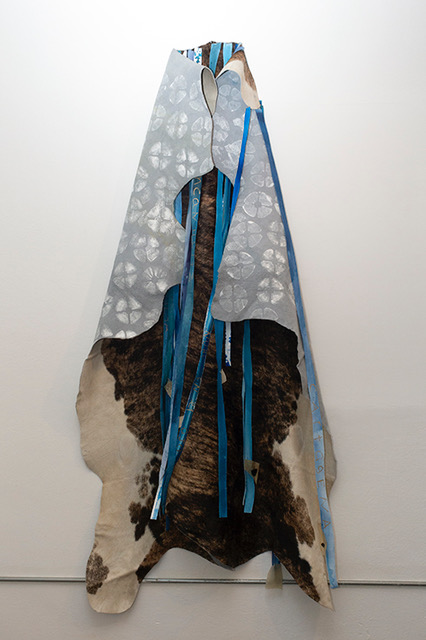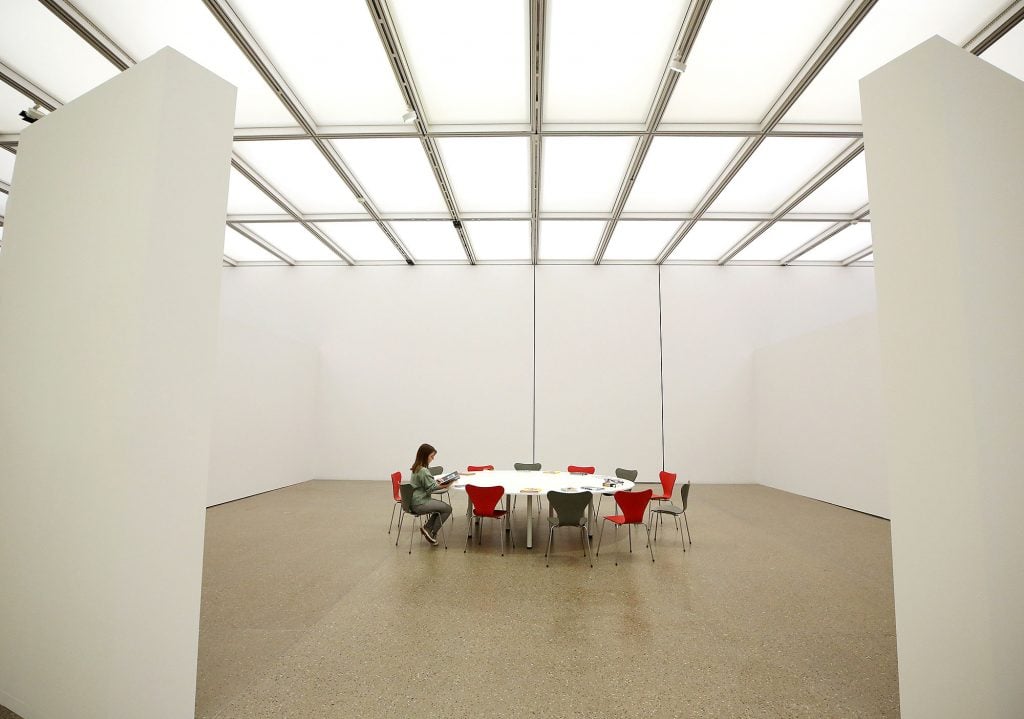Relación de tráfico de personas 1525-1533 I (Study of Trafficking of Persons 1525–1533 I)
2019 - Painting (Painting)
86 5/8 x 39 3/8 inches
Noé Martínez
As he investigates the forms that slavery took through different events that occurred during the sixteenth century in the Huasteca region of Mexico, Noé Martínez tells, in a non-linear narrative, the history of human trafficking in Relación de tráfico de personas 1525-1533 I (Study of Trafficking of Persons 1525–1533 I) . Both the departure of Huasteco Indians from the Americas, and the arrival of Africans from Cape Verde, Angola, Congo and Mozambique unravel in Martinez work as a story that has remained sealed in the colonial archives, and that continues under different guises in contemporary times. Relación de tráfico de personas 1525-1533 I is part of a series made of interventions in tanned leathers that refer to the exchange of human beings for pack animals and cattle in the Caribbean Sea. The back of the leather is stamped with forms mimicking those designs used to brand the bodies of the slaves, while the front carries name inscriptions on painted strips and obsidian stones. This painting follows up on the series of seascape canvases El lenguaje, la lengua y el esclavo congénito , and stands as the closing piece of the artist’s research on colonial enslavement.
Noé Martínez’s practice has questioned the relationship between art, politics and participation, by bringing together biographical accounts of his family’s experience in his native Michoacán, manifestations of ancient indigenous cultures of the region, along with contemporary social mobilizations. Engaging in depthly with local indigenous identities from a contemporary perspective, Martínez’s work asserts the relevance of personal narratives facing Western global history. His work incorporates the evolution of language in relation to the history of the European colonization of Latin America, the vindication of ethnicity in the political processes carried out by the indigenous populations of Mexico, and the political power of memory. His research has recently extended to the colonial history of the Gulf of Mexico, and more specifically the slave trade during the first years of the European invasion. In his paintings, both the exit of Huasteco natives and the entry of Africans from Cape Verde, Angola, Congo, and Mozambique are unraveled as a story that was put away in the high sea, the colonial documents, and the continuation of colonial relations in everyday life.
Colors:
Related works sharing similar palette
» see more

© » KADIST
Pedro Reyes
2005In Reyes’s words, “We should be able to extract the technological nutrients before we excrete our waste...
Related works found in the same semantic group
» see more

© » SLASH PARIS
Des lignes de désir — Exposition félicités 2023 — Beaux-Arts de Paris Palais des Beaux-Arts — Exhibition — Slash Paris Login Newsletter Twitter Facebook Des lignes de désir — Exposition félicités 2023 — Beaux-Arts de Paris Palais des Beaux-Arts — Exhibition — Slash Paris English Français Home Events Artists Venues Magazine Videos Back Previous Next Des lignes de désir — Exposition félicités 2023 Exhibition Mixed media Affiche de l’exposition des félicités 2023 des Beaux-Arts de Paris © Beaux-Arts de Paris Des lignes de désir Exposition félicités 2023 Ends in about 1 month: January 24 → March 17, 2024 Des lignes de désir presents the twenty-eight artists who graduated from the Beaux-Arts de Paris with a Diplôme National Supérieur d’Arts Plastiques and a Congratulations from the Jury in 2023...

© » HYPERALLERGIC
Danielle De Jesus’s Ode to Puerto Rican Bushwick Skip to content Danielle De Jesus, "Puerto Rican Rosary" (2023), oil and packing material on canvas, 48 x 60 inches (all images courtesy Danielle De Jesus) Artist Danielle De Jesus grew up near the intersection of Jefferson Street and Knickerbocker Avenue in a Puerto Rican household in Bushwick, a Brooklyn neighborhood that has steadily gentrified since the mid-aughts, when artists began establishing studios in the warehouses near Flushing Avenue...

© » KADIST
During the week after the the 8th Festival de Performance de Cali (20-24 November 2012), San Francisco will become the setting of a multi-venue series of events organized by the Cali-based collective Helena Producciones (Wilson Díaz, Claudia Patricia Sarria-Macías, Ana María Millán, Andres Sandoval Alba, and Gustavo Racines)...




